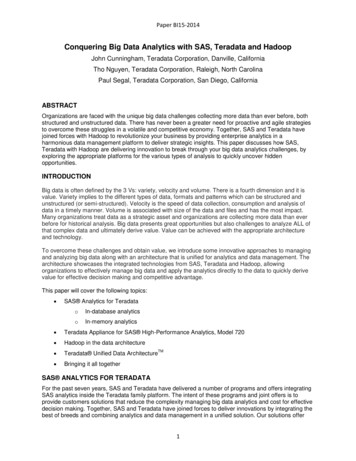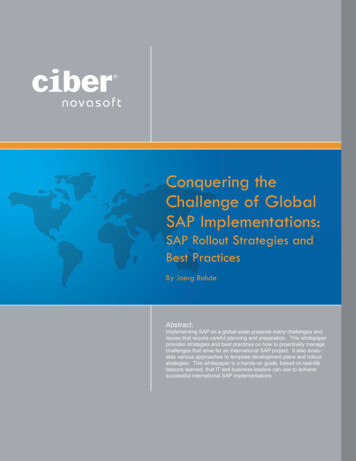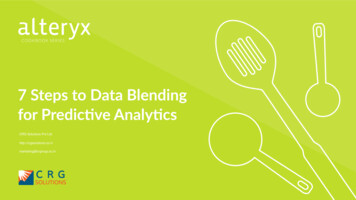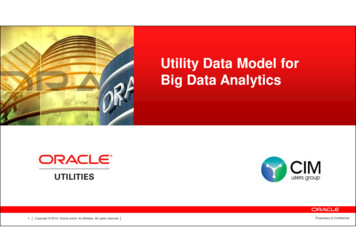
Transcription
Paper BI15-2014Conquering Big Data Analytics with SAS, Teradata and HadoopJohn Cunningham, Teradata Corporation, Danville, CaliforniaTho Nguyen, Teradata Corporation, Raleigh, North CarolinaPaul Segal, Teradata Corporation, San Diego, CaliforniaABSTRACTOrganizations are faced with the unique big data challenges collecting more data than ever before, bothstructured and unstructured data. There has never been a greater need for proactive and agile strategiesto overcome these struggles in a volatile and competitive economy. Together, SAS and Teradata havejoined forces with Hadoop to revolutionize your business by providing enterprise analytics in aharmonious data management platform to deliver strategic insights. This paper discusses how SAS,Teradata with Hadoop are delivering innovation to break through your big data analytics challenges, byexploring the appropriate platforms for the various types of analysis to quickly uncover hiddenopportunities.INTRODUCTIONBig data is often defined by the 3 Vs: variety, velocity and volume. There is a fourth dimension and it isvalue. Variety implies to the different types of data, formats and patterns which can be structured andunstructured (or semi-structured). Velocity is the speed of data collection, consumption and analysis ofdata in a timely manner. Volume is associated with size of the data and files and has the most impact.Many organizations treat data as a strategic asset and organizations are collecting more data than everbefore for historical analysis. Big data presents great opportunities but also challenges to analyze ALL ofthat complex data and ultimately derive value. Value can be achieved with the appropriate architectureand technology.To overcome these challenges and obtain value, we introduce some innovative approaches to managingand analyzing big data along with an architecture that is unified for analytics and data management. Thearchitecture showcases the integrated technologies from SAS, Teradata and Hadoop, allowingorganizations to effectively manage big data and apply the analytics directly to the data to quickly derivevalue for effective decision making and competitive advantage.This paper will cover the following topics: SAS Analytics for TeradataoIn-database analyticsoIn-memory analytics Teradata Appliance for SAS High-Performance Analytics, Model 720 Hadoop in the data architecture Teradata Unified Data Architecture Bringing it all togetherTMSAS ANALYTICS FOR TERADATAFor the past seven years, SAS and Teradata have delivered a number of programs and offers integratingSAS analytics inside the Teradata family platform. The intent of these programs and joint offers is toprovide customers solutions that reduce the complexity managing big data analytics and cost for effectivedecision making. Together, SAS and Teradata have joined forces to deliver innovations by integrating thebest of breeds and combining analytics and data management in a unified solution. Our solutions offer1
Paper BI15-2014, continuedend-to-end capabilities ranging from data exploration, data preparation, model development and modeldeployment. We have developed horizontal and vertical offers to meet customers’ needs specifically forbig data analytics.There are two key technologies that dramatically improve and increase performance when analyzing bigdata: “in”-database and “in”-memory analytics.IN-DATABASE ANALYTICSIn-database analytics refer to the integration of advanced analytics into the data warehousing. With thiscapability, analytic processing is optimized, to run where the data reside, in parallel, without having tocopy or move the data for analysis. Many analytical computing solutions and large databases use thistechnology because it provides significant performance improvements over the traditional methods. Thus,in-database analytics have been adopted by many SAS business analysts who have been able to realizethe benefits of streamlined processing and increased performance. With SAS in-database analytics forTeradata, SAS users have the ability to develop complex data models and score the model in the datawarehouse. By doing so, it removes the need to either move or extract the data to a SAS environment orconvert the analytical code to something that could be executed on the data platform.By applying the analytics to where the data reside, it significantly streamlines the process by eliminatingdata movement and redundancy. In addition, it greatly improves data integrity by not having to copy andmove the data to a silo data server. The improved performance comes from leveraging the power of theTeradata data warehouse with its massively parallelize processing (MPP) architecture. The MPParchitecture is a “shared nothing” environment and can take disseminate large queries across nodes forsimultaneous processing. It is capable of high data consumption rates through parallelized datamovement which means completing any task at a fraction of the time. The diagram below illustrates thein-database processing.Figure 1: In-database processing: Minimize data movement and redundancyIn-database processing includes data preparation, data modeling and model scoring – all of which can beexecuted inside the Teradata data warehouse. The in-database approach dramatically streamlines theprocess compared to the traditional method and insights can be delivered to business and IT faster forinformed business decisions.As referenced in Figure 1, data preparation can be executed inside the data warehouse. For datapreparation, the following products are integrated with Teradata2
Paper BI15-2014, continued SAS/ACCESS Interface to Teradata - a data adapter that can interface directly with TeradataBASE SAS – a selected set of PROCS o PROC SUMMARYo PROC MEANSo PROC FREQo PROC RANKo PROC TABULATEo PROC REPORTo PROC SORTSAS Data Quality Accelerator for Teradata – data quality functions to cleanse and integrate the data o Matchingo Parsingo Extractiono Standardizationo Casingo Pattern analysiso Identification analysiso Gender analysisSAS Code Accelerator for Teradata - simplifies and speeds data preparation with user-definedmethods utilizing DS2 programming languageFor data modeling, the following products are integrated with Teradata SAS Analytics Accelerator for Teradata – a set of PROCs to develop and deploy modelso SAS/STAT PROC REG PROC PRINCOMP PROC VARCLUS PROC SCORE PROC CORR PROC FACTOR PROC CANCORRooSAS Enterprise Miner PROC DMDB PROC DMINE PROC DMREG (Logistic Regression)SAS ETS PROC TIMESERIESFor model scoring, there following products are integrated with Teradata. SAS Scoring Accelerator for Teradata – scoring of models from SAS Enterprise Miner and SASSTATIn addition to the above products and capabilities, we have additional in-database offers and solutions. Business Insight Advantage Program - A complete certified solution for Data Management &Quality, Business Intelligence and Analytics that includes Teradata Database & hardware, SASsoftware and joint services Anti-Money Laundering (AML) Advantage Program – A complete Anti-Money Launderingsolution built around SAS AML with Teradata for running scenarios and risk factors in-database. Credit Risk Advantage Program - A solution integrating SAS Credit Risk with Teradata and theFinancial Services Logical Data Model FS-LDM. Credit Scoring Advantage Program - Execute SAS Credit Scoring functions inside the Teradatadatabase at extraordinary speed to manage credit application adjudication and portfoliomanagement.3
Paper BI15-2014, continued Warranty Analysis Advantage Program – A combined solution of SAS Warranty Analysis andTeradata Early Warning Analytics with associated hardware and software, services.As the partnership matures, we have evolved from in-database to in-memory analytics.IN-MEMORY ANALYTICSThe SAS in-memory environment leverages Teradata’s MPP (Massively Parallel Processing) architecturewhich is ideal for retaining, preparing and partitioning large data sets for big data analytics. It is capable ofhigh data consumption rates through parallelized data movement which means completing any task at afraction of the time. This latest innovation provides an entirely new approach to tackle big data by usingan in-memory analytics engine to deliver super-fast responses to complex analytical problems. It is a setof products beyond SAS Foundation technologies to explore and develop data models using all of yourdata.The SAS Foundation software is located on a user’s workstation or on a SAS server. When it runs a SASprogram containing High-Performance procedures or analytics, it initially connects to the Teradatadatabase containing the source data, and then it instigates a parallel computing job on the SASprocessing nodes. One of the SAS nodes is designated to be the controlling root node and the othernodes are worker nodes.The SAS client coordinates with the root node, and the root node in turn directs with the correspondingprocesses on the worker nodes. The worker processes are multi-threaded to take advantage of the largenumber of CPUs. Therefore, once an in-memory analytics process runs on the appliance, all of the nodesare dedicated to that specific task. Analysis can be executed in minutes or seconds using this approach.Teradata Appliance for SAS HighPerformance Analytics, Model 720SAS Client(s)Figure 2: In-memory processingWhen all of the processes are running for an in-memory task, the root node submits a SQL query toTeradata that causes the SAS Embedded Process (EP) table function to read data from the database andsend it to a SAS in-memory worker. Teradata was designed to multi-threaded. For a specific SQLrequest, each thread is called an AMP worker thread. Since the SAS EP is also multi-threaded, it makesa connection from every Teradata AMP to a SAS worker.4
Paper BI15-2014, continuedAfter the data is transferred to memory and while the SAS in-memory job is active, there is no activity inthe Teradata database. Thus, there is no performance impact to the Teradata database as data is onlylifted into memory when requested. SAS software coordinates the analytical processing between theSAS client that is running the procedure, the SAS HPA root node, and the SAS worker nodes. All of thenodes in the Teradata Appliance for SAS are designated to compute the analytical tasks.When the SAS HPA in-memory processing is complete, results can be written back to Teradata into apermanent client for additional analysis, depending on the type of procedure and the procedure optionsthat are selected.TERADATA APPLIANCE FOR SAS HIGH-PERFORMANCE ANALYTICS, MODEL 720The Teradata Appliance for SAS High-Performance Analytics, Model 720 is specifically for SAS HighPerformance Analytics Products and SAS Visual Analytics, integrating SAS in-memory capabilities withthe industry leading data warehouse platform, for data model development and data visualization. Jointlydeveloped with SAS, the Teradata Appliance for SAS High-Performance Analytics, Model 720 eliminatesthe need to copy data to a separate appliance with dedicated SAS nodes for in-memory processing.There are a number of SAS products that seamlessly integrate with the Model 720. SAS Visual Analytics - Explore massive volumes of data to quickly to visualize and uncover patternsand trends for further analysisSAS High-Performance Analytics Productso SAS High-Performance Statistics: Enables use of predictive models for faster and moreeffective decision-making.o SAS High-Performance Data Mining: Develops predictive models using thousands ofvariables to produce more accurate and timely insights.o SAS High-Performance Text Mining: Explores all your data, including textual information, togain rich new knowledge from previously unknown themes and connections.o SAS High-Performance Forecasting: Generates models for faster high-value and timesensitive decision making, using thousands or even millions of granular-level forecasts.o SAS High-Performance Econometrics: Provides econometric modeling facility, such as thenumber and severity of events, using big data.o SAS High-Performance Optimization: Performs more frequent modeling iterations anduses sophisticated analytics to get answers to questions you never thought of or had time toask.By leveraging analytical features, including statistics, data mining, text mining, forecasting econometricsand optimization, organizations can quickly identify and add important variables. More data modeliterations can be performed to gain understanding and make decisions with confidence.The Teradata Appliance for SAS High-Performance Analytics readily extends the entire TeradataPlatform Family as shown in Figure 3, providing ultra-high speed SAS In-Memory Analytics againstTeradata Data Warehouses and Appliances. The appliance features clustered servers, each with dualIntel eight core Sandy Bridge processors, SUSE Linux operating system, 128-256GB of RAM, andenterprise class Infiniband networking infrastructure—into a power-efficient system. The applianceconnects directly to Teradata BYNET, ensuring unsurpassed data access speeds, 50-250x faster thantraditional ODBC, and superior analytic processing. Best of all, the solution is supported by the mosttrusted name in data warehousing—Teradata.5
Paper BI15-2014, continuedFigure 3: Teradata Platform Family Connects with Model 720The Teradata Appliance for SAS High-Performance Analytics, Model 720 enables advanced analyticswith incredibly fast parallel processing, scalability to process massive volumes of data, and rich inmemory analytics capabilities. This environment provides a set of in-memory analytics algorithms thatleverages the database’s speed, while eliminating time-consuming and costly data analysis. ThisTeradata appliance includes analytical capabilities spanning data visualization and data modeldevelopment executed in a highly scalable, in-memory processing architecture. It will let customersexplore massive volu
SAS Data Quality Accelerator for Teradata –data quality functions to cleanse and integrate the data o Matching o Parsing o Extraction o Standardization o Casing o Pattern analysis o Identification analysis o Gender analysis SAS Code Accelerator for Teradata - simplifies and speeds data preparation with user-defined methods utilizing DS2 programming language For data modeling, the following .











